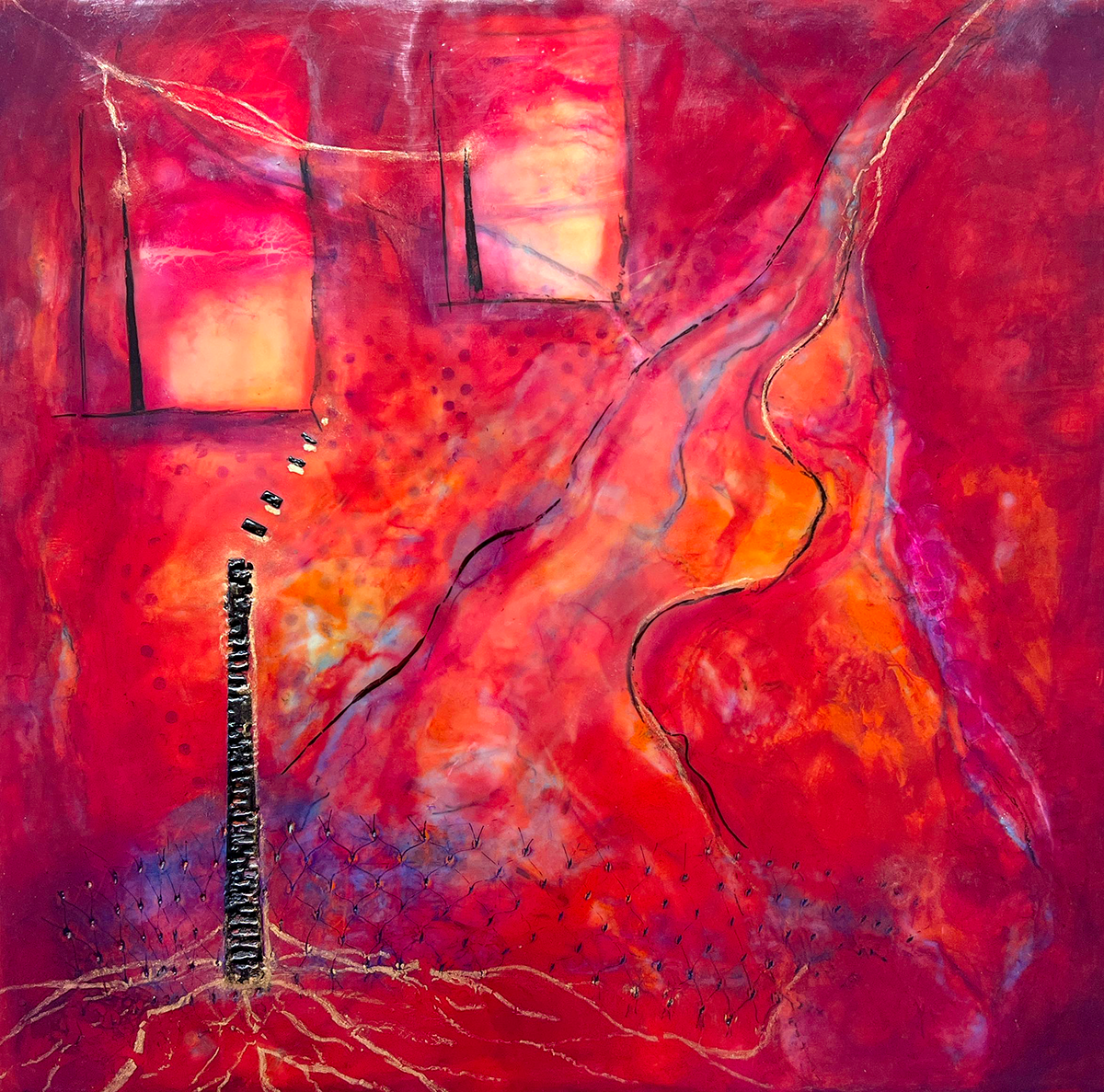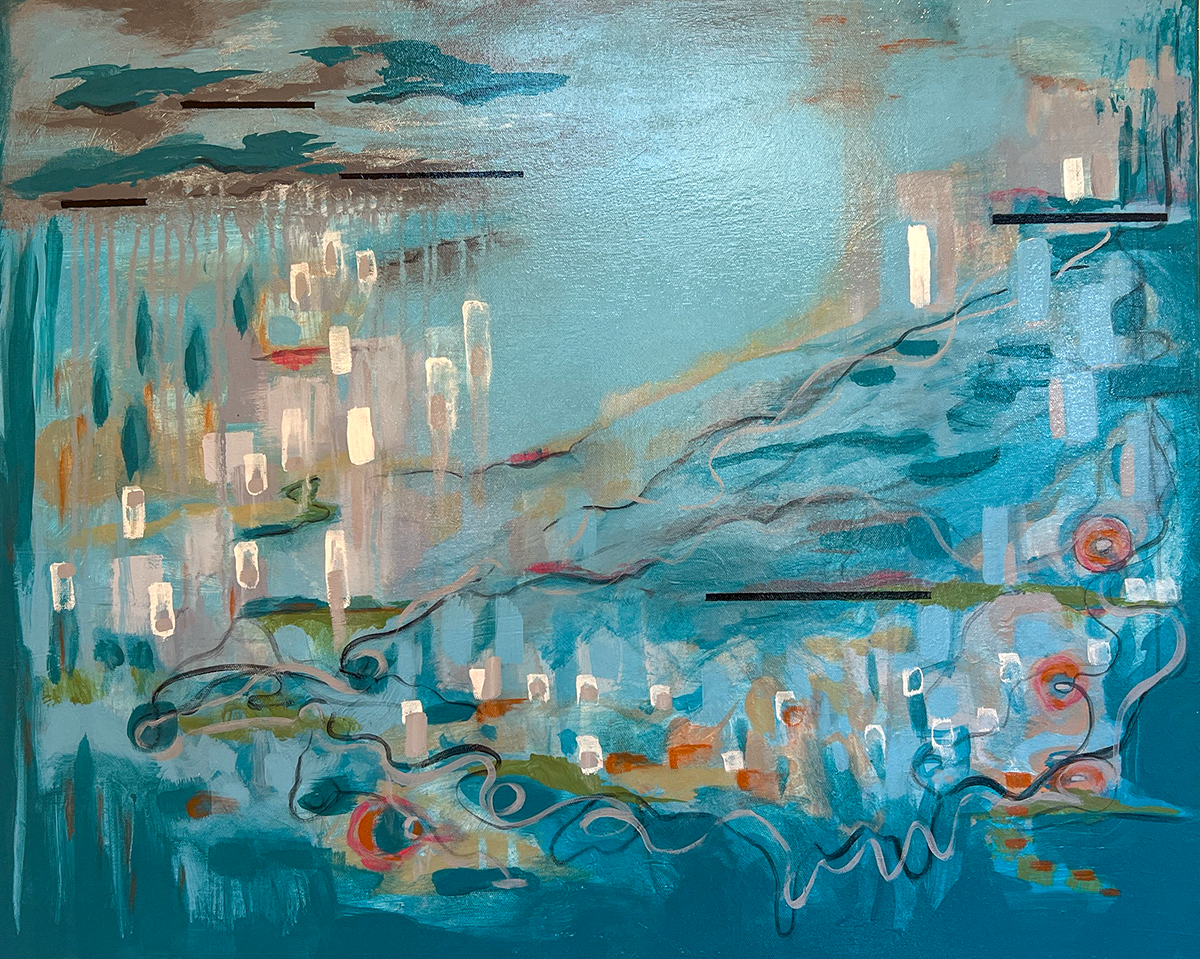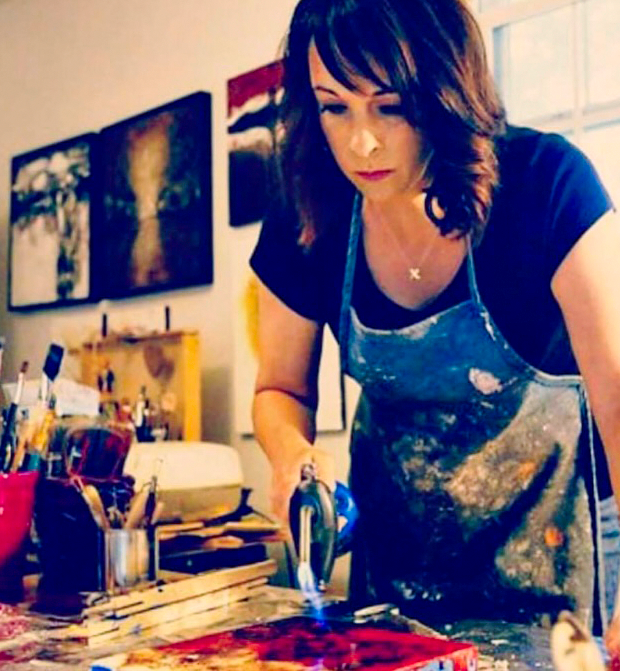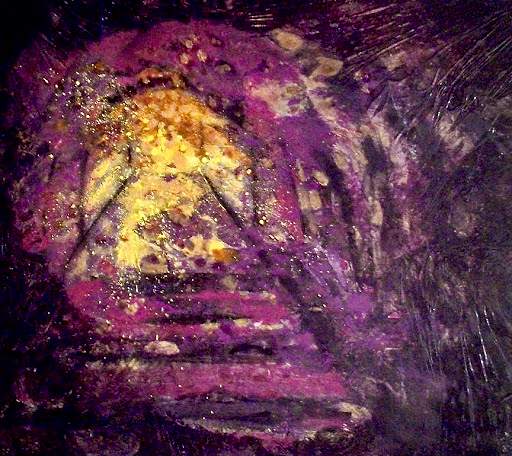Mixing Colors with Terri Yacovelli
“What was, What is, What could be” — encaustic on panel, © 2022 by Terri Yacovelli
Walking into "Mixing Color," the newest exhibit at York's Gallery @ 227, one gets the sense that the artist wants the viewer to have insight into their work. The word choices, actions, and even tone of voice are giveaways.
While artists and galleries often consider how and where to hang works in an exhibit, how the ensemble works together visually is only part of the consideration in Terri Yacovelli's display. Instead, roughly three dozen pieces are arranged in collections, each with textual readings that give visitors greater understanding and appreciation of the commonality of the artworks and the artist's thought process. Titles of a number of the works touch on music that Terri has listened to, from a diverse range that includes rapper Mac Miller, pop star Taylor Swift, or Miles Davis' jazz classic "Kind of Blue," influencing a similarly titled visual piece.
“Kind of Blue” — encaustic on panel, © 2022 by Terri Yacovelli
“Atlantis” — Acrylic on canvas, © 2021 by Terri Yacovelli
Terri was kind enough to let us into her thought process in a recent interview preceding the exhibit.
Andrew Smith: "You trained as an oil painter but now focus on encaustic works. What is encaustic? When and how did you become attracted to the medium?"
Terri Yacovelli: "I have always been drawn to encaustic art, so I took a workshop in 2014. Encaustic paint is heated beeswax with pigment added, so it is very fluid and can be poured, stamped, or carved. Each layer is fused to the previous with a blowtorch. The tools used in encaustic are often the same you use for hand building with clay. The earthy smell of the beeswax and using the wax to create interesting surface texture had me hooked right away. I think having previous painting and sculpture experience helped me get a handle on the medium.
For example, when I painted with oils, I liked to build up a strong underpainting first, then glaze more layers on top. This is a good way to work with encaustic. Layering opaque and transparent encaustic colors creates paintings that suggest luminosity, depth, and dimension. You do this by adjusting how much beeswax medium is added to the color. You can scrape through to expose previous layers and color. There is heightened visual interest since marks can be hidden and revealed."
“Soul Plan (Ascension)” — encaustic on panel, © 2022, by Terri Yacovelli
AS: "These less traditional art mediums often lead their artists to experimentation. How do you view the role of experimentation in art in general and more specifically in encaustic works?"
TY: "Experimentation is important; you have to be willing to make mistakes in order to move forward. I made the conscious choice not to take a bunch of encaustic classes at first. Because I have been teaching studio art for a long time, I was excited about using something I didn't know much about. I was the student for a change and wanted to allow myself the joy of discovery.
This gave me a playfulness with the materials, and I couldn't wait to try different things. I searched for weird textures to imprint into the surface. I embedded string, coffee, couscous, and leaves into the wax. I even made a 'chocolate wax' medium with Wolfgang chocolate for an Arts & Industry Exhibit at Creative York. (My studio smelled delicious, and the paintings do too!) All of this meant I had some epic failures along the way, but I certainly learned what to do and what not to do. Since starting, I have completed a lot of research on my own and have worked with other encaustic artists to learn new techniques to expand my skills. It has been an investment in both time and materials."
“Channel Orange” — encaustic on panel, © 2022 by Terri Yacovelli
AS: "Perhaps related — How important is Process in your work? Any insights?"
TY: "Process is as important as the product. I'm glad that I started using encaustic in the manner that I did because the wax can be frustrating; it often has a will of its own. You can't fight with it. When it's hot out, or if you over fuse with the blowtorch, the wax takes forever to set. You can't move on with the piece. If it's too cold, the wax sets up too fast. Sometimes your plan works out, and other times you have to give in to the medium and the moment and just let go. That was hard for me as a structured, type "A" person, to let the painting lead the way. The lessons we learn during our studio practice can be applied to physical, mental, and emotional aspects of our everyday lives. It's not unlike having a yoga practice; everything we learn in yoga class can be translated off your mat and into the real world. The creative process is the same way."
AS: "You note that you've been an art educator. What courses have you taught, and how has teaching impacted you?"
TY: "I recently left public education after teaching studio art for 30 years. I also served as an adjunct professor at York college for 19 of those years, where I taught an art education course and an art appreciation course. Teaching to different types of students has strongly reinforced my belief that art is for everyone. We are born with the inherent need to create, but somehow, life discourages us to fully express ourselves. I always want to help others use their art to find their voice. Making art is not just about making something that looks great; it's about the challenge and enjoyment of creating and having pride in resolving a problem. A project gives us a purpose.
I also realized that in regard to discussing art, people just don't know how; they need more information and are hesitant to ask. They will discuss music or movies in depth and with detail, yet often respond to art with a 'like it/don't like it.' People will sometimes critique art solely on what they know about the artist in question instead of focusing on the physical art itself. Giving people the language and tools to develop a deeper understanding of the creative process is a passion for me. It opens a whole new visual appreciation when you learn to address an artwork's formal elements—visual attributes such as color, line, texture, and materials. Considering culture and historical context, artists' intention and interpretations of meaning are another layer. You can be an advocate and participate in the art world without making it, or this understanding can enhance your own artwork."
AS: "Your current exhibit emphasizes color, and you discuss that on your website regarding spiritual and behavioral aspects. Did you feel these connections early in your artwork, or is this something that developed over time? Do you experience these differently when working with encaustic techniques than with oil paints?"
TY: "When I started painting, I worked realistically with oils, focusing on portraiture. I actually did research on modern portraiture and an exhibition of portraits for my master's thesis. (Above: “Portrait of Susan Williamson” — oil on canvas, © 1995 by Terri Yacovelli)
When I was around thirty, I lost quite a few people in my life within a few years of each other, some tragically. It really affected me; I had sort of an existential crisis. I lost the desire to paint images of people. I would just mix colors and listen to music, not worrying about 'making' anything. That led to experimenting with mixed media, combining watercolor and tempera, and when dry, adding a layer of pastel chalk to create colorful abstracts.
Symbols of doorways, portals, and paths emerged in my work. (Right: “Violet Portal 1” — mixed media on paper, © 2008 by Terri Yacovelli)
The series was not a conscious decision; the work evolved on its own. Focusing on mark-making and color exploration gave me space to process things; it was very healing. I find I have been revisiting this with my encaustic work, and things have come full circle. Partly because of the nature of the medium, but more likely in reaction to the state of the world. My art has become part of my spiritual practice, a meditative way to visually express what I may not be able to say with words. There are works that are very important to me on a personal level that I know I won't part with, but selling work isn't as important as creating an authentic expression. It's very gratifying when others make a connection with the work, but if they don't, that's ok too. I'm going to keep on painting either way."
"Mixing Color"
September, 2022
Gallery @227, Codorus & Company, York PA
Terri Yacovelli’s work is found online at:
www.terriyacovelli.com
All works copyright Terri Yacovelli and/or Andrew T. Smith

















